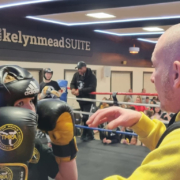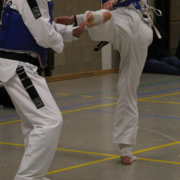Your First Kickboxing Competition Representing TMKA
Stepping into your first kickboxing competition as a representative of TMKA Kickboxing Milton Keynes is a powerful moment; one filled with anticipation, adrenaline, and pride.
This is not just about testing your skills in the ring; it’s about stepping up to a new level of personal growth, honouring the training you’ve undergone, and representing a community that stands for discipline, respect, and excellence. With the guidance of TMKA’s Chief Instructor, Sensei Mark Featherstone—a 6th Dan Black Belt and world-class martial artist—you’ll be walking into that arena backed by experience, structure, and unwavering support.
As the competition approaches, your training intensifies, not just physically but mentally. The TMKA system is carefully designed to ensure that students at every level are prepared, especially when it’s their first time competing. You’ll be working on sharpening your combinations, fine-tuning your footwork, and mastering defensive maneuvers. Sparring becomes more purposeful. Your instructors and teammates help simulate the pressure you’ll feel on fight day—so when you finally touch gloves in the ring, the moment doesn’t overwhelm you. You’ve already been there, mentally and physically, in class.
Your first competition will also be a lesson in preparation beyond the physical. You’ll learn the importance of mindset—how to handle nerves, channel energy, and focus your breathing to stay calm and sharp. TMKA puts great emphasis on life skills like confidence, self-control, and perseverance, and those will serve you more than ever during this experience. Sensei Mark and the team will guide you through mental strategies to maintain composure, encouraging visualisation and positive self-talk to help you stay focused and centered in the build-up to your fight.
One of the most unique things about representing TMKA Kickboxing Milton Keynes is the sense of unity. Whether you’re a junior or an adult, a beginner or an advanced student, you are part of a family. On competition day, you won’t be alone. Your coaches, teammates, and even students not competing will be there to support you; wrapping your hands, helping with warm-ups, cheering from the sidelines, and celebrating your courage regardless of the outcome. This sense of camaraderie is a hallmark of TMKA culture. You’re never just a fighter, you’re a representative of the values and standards of the academy.
Your gear will be checked, your name will be called, and you’ll step up to the mat or into the ring knowing that everything you’ve done in training has brought you here. Whether you win or lose, this first competition will mark a turning point in your martial arts journey. You’ll learn about your strengths, your gaps, and your potential. You’ll walk away not just with the experience of combat, but with a deeper understanding of yourself and a renewed respect for the art of kickboxing.
It’s also important to acknowledge the discipline and bravery it takes to put yourself on the line in competition. Not everyone is willing to test themselves in this way, and at TMKA, that effort is celebrated and respected. You will gain the respect of your peers simply by showing up, giving it your all, and embodying the true spirit of martial arts.
After your match, you’ll debrief with your coaches. You’ll go over what went well and what needs work. TMKA isn’t just about throwing students into the ring; it’s about nurturing long-term growth and progress. Your first competition will open the door to many more opportunities—gradings, future tournaments, perhaps even national titles one day. But it all starts with that one match, that first time you represent the TMKA name in competition.
So when the day comes, wear the logo on your back with pride. Represent TMKA Kickboxing Milton Keynes with honour, discipline, and heart. No matter the result, walking into your first competition marks you as a martial artist in the truest sense—committed, courageous, and ready to grow.
#TopMarksKickboxingAcademy
#kickboxingtraining
#martialarts
#greatlinfordmemorialhall
##newportpagnellyouthclub










 so inspiring witnessing all levels stepping up today
so inspiring witnessing all levels stepping up today  Highlight of my year is awarding the TMKA Grand Championship awards ….always given to students who have just done that little bit more over the year. This year’s awards went to 4 amazing TMKA students….Esmae Ludgate (7), Harry Ludgate (14), Laila Featherstone (14), Paul Jones (50).
Highlight of my year is awarding the TMKA Grand Championship awards ….always given to students who have just done that little bit more over the year. This year’s awards went to 4 amazing TMKA students….Esmae Ludgate (7), Harry Ludgate (14), Laila Featherstone (14), Paul Jones (50).




 t-shirts……..completing 5 ring fights at such young ages
t-shirts……..completing 5 ring fights at such young ages 
